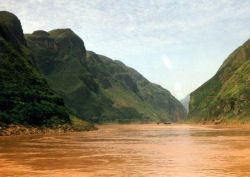Soil Erosion (2/2)
Soil Erosion
Soil erosion has on-site and off-site effects. The on-site effects are observed at the location where the soil was removed. When soil erosion has progressed, the entire top layer of the soil is absent and the underlying rock soil is revealed.

Source: UN photo#106680 by John Olsson
The top soil layer is essential for the growth of vegetation, because it is where the plants receive nutrients and water from. Also, its loose constitution allows the plants to grow roots, which, in addition to nutrition, are essential for the plants to stay erect and grow upwards.
The off-site effects involve the areas where the soil was deposited. Water is one of the main carriers and soil is frequently moved through rivers and streams. In those cases it is deposited in areas wherever the water in the river slows down. This happens in sharp turns of the river and at its delta, where it meets the sea. The deposition of soil in the rivers can alter its depth, width and flow, causing additional side-effects. Fish population can be affected due to this changes, as well as the vegetation that grows at the banks of the river. In addition, the amount of fresh water that enters the oceans has different properties, due to the changes on the structure of the river.
Eroded soil is rich in organic matter and nutrients. Additionally, the eroded soil can also contain chemical residues of fertilisers or pesticides that were used near the areas where the eroded soil originated from. These chemicals can contaminate the rivers and disrupt the biodiversity of the organisms living inside the river or on its banks, the lakes that the river is feeding or even in the sea where the river ends.
Soil erosion has undesirable effects for the people and the environemt. The loss of top soil restricts, or completely prohibits, the growth of vegetation. As a result, heavily eroded lands are not suitable for agriculture. In addition, the removal of top soil from one area and its deposition in another, has severe impacts in those ecosystems, affecting the microbial, animal and plant population and diversity of those ecosystems.
Question: Why does the sea water near the river delta has a brown colour?


